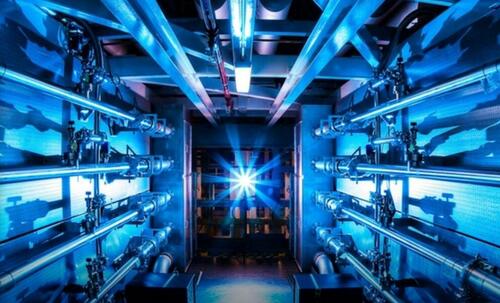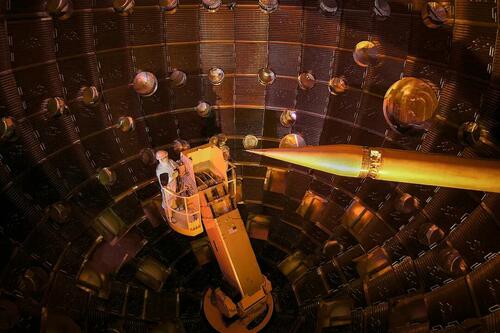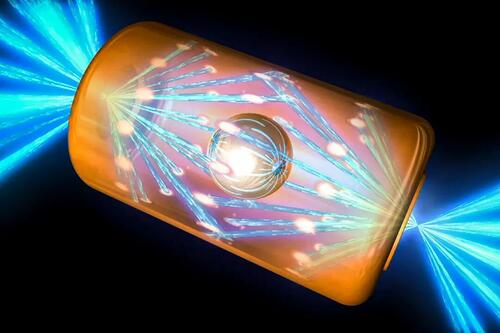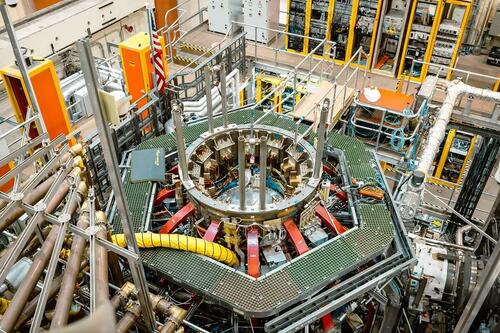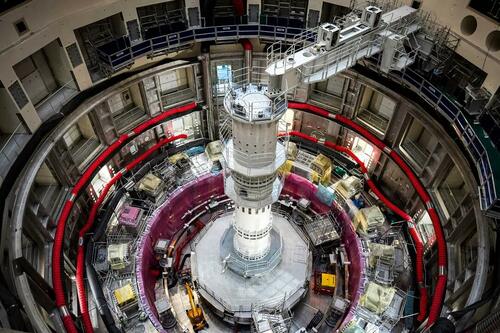Nuclear Fusion, A Perpetually Distant Dream, Moves Closer To Reality
Authored by Kevin Stocklin via The Epoch Times (emphasis ours),
Generating nearly limitless, clean, carbon-free energy from nuclear fusion—a vision that seems to be perpetually out of reach—has taken major steps in the past several years toward becoming a reality.
On the heels of major recent breakthroughs in physics labs in generating nuclear fusion, the quest has now expanded into the private sector, where a proliferation of start-up companies are racing to make the process commercially viable, and profitable.
If they succeed, the prize would be an abundant source of virtually carbon-free energy that does not consume vast acres of natural landscapes and coastal areas, as do solar panels and wind turbines. And, unlike today’s nuclear-fission reactors, fusion energy produces relatively little radioactive waste.
Tritium and deuterium, isotopes of hydrogen, are the elements used in fusion, rather than heavy elements like uranium and plutonium that are used in fission. The final products of a fusion reaction are helium and neutrons.
Besides producing less waste, nuclear fusion does not entail the risk of runaway chain reactions like Chernobyl, scientists say.
If a fission plant shuts down during an emergency, “it can still produce a lot of power for a while from the leftover activity in the reactor, and this is why it melts,” Jean Barrette, physics professor emeritus at McGill University, told The Epoch Times.
“Whereas with nuclear fusion, you turn the switch off and it’s over; it doesn’t have any leftover radiation.”
While the potential benefits from fusion are manifold, harnessing it for electricity remains a daunting task.
“The fundamental process is well known, and of course, that’s what powers the stars,” Robert Fedosejevs, professor of electrical engineering at the University of Alberta and a specialist in laser technology, told The Epoch Times. But “fusion is the most technologically challenging approach to making energy that mankind has ever attempted.”
Within stars, immense gravity creates intense heat and pressure that causes several hydrogen nuclei to fuse into a single helium nucleus. There is a slight loss of mass in this process, and that “missing” mass is converted into enormous amounts of energy according to Albert Einstein’s famous equation, e = mc².
Absent the gravity of the sun, however, the challenge on earth is not only creating continuous fusion, but doing it in a way that doesn’t require more energy than it produces.
In December 2022, the Lawrence Livermore National Laboratory’s National Ignition Facility (NIF) in California crossed this threshold. Through the work of about 1,000 U.S. and international scientists, the NIF created a fusion reaction that, for the first time, produced more energy than it consumed.
It was done by firing 192 simultaneous laser beams into a tiny peppercorn-sized capsule of deuterium and tritium (DT) to compress and heat it to temperatures between 50-100 million degrees Kelvin until it fused, with the product being a helium ion, a neutron, and energy.
“They’ve basically produced multi mega joules of fusion energy, with only two mega joules of laser energy going in,” Fedosejevs said. “That’s the scientific benchmark that people have been working toward for the last 50 to 60 years, to at least show that in the laboratory you can generate more energy out than in.
“So there’s no question fusion works. It’s really, how can we technically achieve it in a sustainable fashion as a power source?”
Moving From Labs to Functional Reactors
Going from a one-off, nano-second reaction in a laboratory to the reliable and cost-effective production of electricity is where scientists, engineers, and investors around the globe are turning their focus.
“We are very, very far away from working plants,” Barrette said. “You need success in many, many directions.
“It’s not one thing they’re missing. They’re missing many things right now that all have to work to make an efficient reactor.”
The first is how to create sustained reactions through fusion, in order to generate base-load electricity. Development in this area is going down one of two paths: laser inertial confinement fusion, the process used by NIF, and magnetic confinement fusion, which uses a magnetic field to simulate the intense gravity within stars.
Laser fusion, which Fedosejevs describes as a “micro-implosion in a vacuum vessel driven by an ultra-short laser pulse,” has taken the lead in terms of producing net energy gains from the reaction. The DT fuel targets are meticulously arranged, and the lasers are all aimed precisely at a space about the width of a human hair.
They are then fired once before having to be recharged and re-aimed. The process allows for about one reaction per day.
To become viable for electricity generation, lasers would have to fire at least 100 times per second, Barrette said, and although solving this and other problems is not impossible, “they are now still very much in the research phase.”
Innovators in this space are working to develop more powerful lasers that can operate at a much higher repetition rate in order to produce energy continuously.
An August report in Physics Today written by nuclear scientists Stefano Atzeni and Debra Callahan, however, notes that the NIF’s laser-based fusion was conducted with 30-year-old laser technology and that progress in laser and target technology has now advanced to the point that laser fusion continues to be seen as potentially commercially viable.
By contrast to laser fusion, magnetic fusion relies on a powerful magnetic field to create the conditions necessary for fusion to take place.
With magnetic fusion, a machine called a tokamak, a design that originated in the Soviet Union in the 1950s, uses magnetic fields to confine, compress, and heat DT plasma within a donut-shaped reactor called a torus. Once fusion occurs, the product is a helium ion and a neutron. These neutrons are able to pass through the magnetic field, and as they do they are captured by a “blanket” outside the wall; this is the primary source of the heat that would ultimately generate electricity.
Over the decades since its invention, scientists have worked to develop ever-stronger magnets to generate more energy for longer durations.
In 1982, Princeton Plasma Physics Laboratory created its Tokamak Fusion Test Reactor (TFTR), which set a number of world records, including heating plasma to 510 million degrees centigrade, well beyond the 100 million degrees required for commercial fusion. These temperatures exceed those at the center of the sun, which NASA estimates are about 15 million degrees centigrade.
In 1994, the TFTR generated a record 10.7 million watts of controlled fusion energy, which would power more than 3,000 homes.
England also operates a tokamak, called the Joint European Torus (JET), which has also succeeded in generating record amounts of fusion energy. In addition, scientists from 35 countries collaborated on the ITER tokamak in France, which will be the largest superconducting magnet ever built and is scheduled to begin operating in 2034.
“It will produce a field of 13 tesla, equivalent to 280,000 times the Earth’s magnetic field,” a U.S. Department of Energy (DOE) report states. While laser fusion currently leads in terms of demonstrated energy output, magnetic fusion may hold more promise for generating the continuous energy output necessary for base-load electricity.
“Tokamaks can sustain plasma currents at the mega-ampere level, which is equivalent to the electric current in the most powerful bolts of lightning,” the DOE states. “Fusion energy scientists believe that tokamaks are the leading plasma confinement concept for future fusion power plants.”
Not to be left behind, China has built the Experimental Advanced Superconducting Tokamak (EAST) in Hefei, which has also operated successfully.
The Challenges of the ‘Wall’
Alongside the quest to develop commercially viable fusion reactions, an equally tall hurdle is figuring out how to build a functional, durable physical structure to contain and draw energy from the reactions.
“We had the idea of ‘let’s put the sun in a bottle,’ and it turns out the hard part was not really creating the sun,” Eric Emdee, a research physicist at the Princeton Plasma Physics Laboratory (PPPL), told The Epoch Times.
“We’ve created very high temperature plasmas, temperatures that are optimal for fusion to happen,” he said. “The hard part is creating the bottle.”
Within a tokamak reactor, the DT plasma, contained within a magnetic field, is surrounded by a physical wall, called a plasma facing component (PFC) that must withstand the 100 million-degree heat from the reaction.
Read the rest here…
Tyler Durden
Tue, 09/03/2024 – 03:30
via ZeroHedge News https://ift.tt/jO8gx6K Tyler Durden
